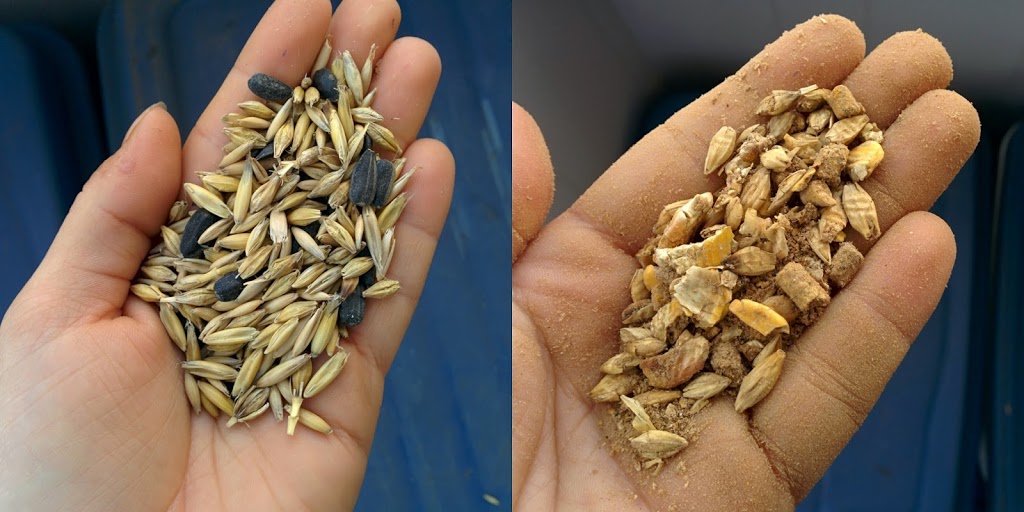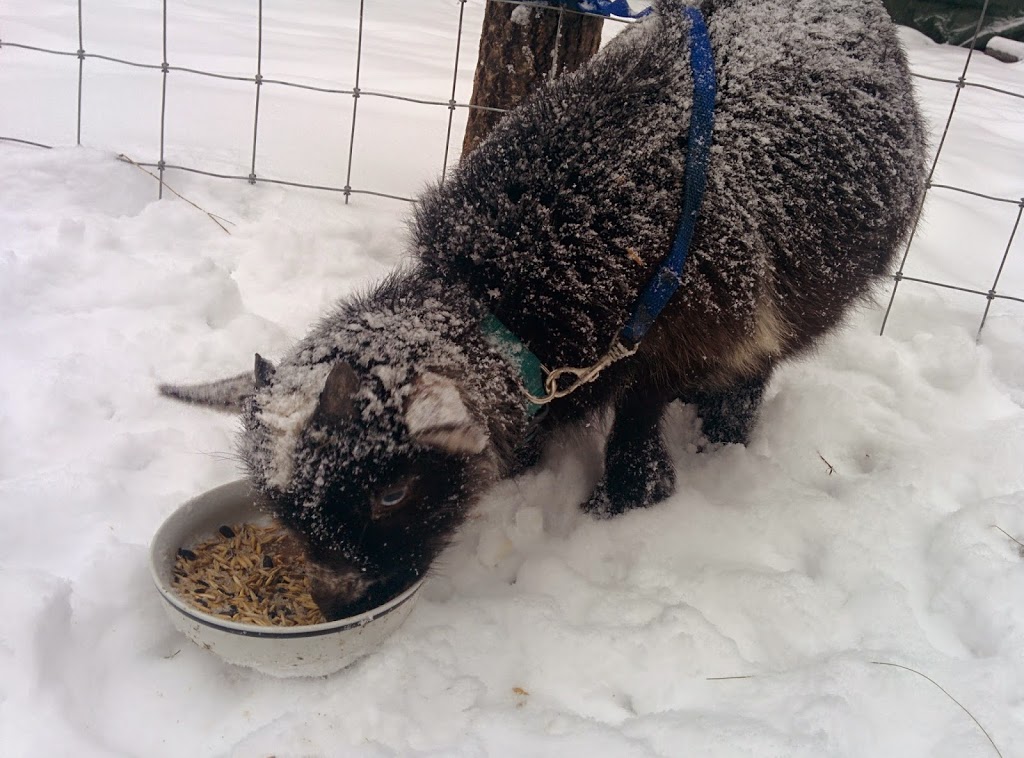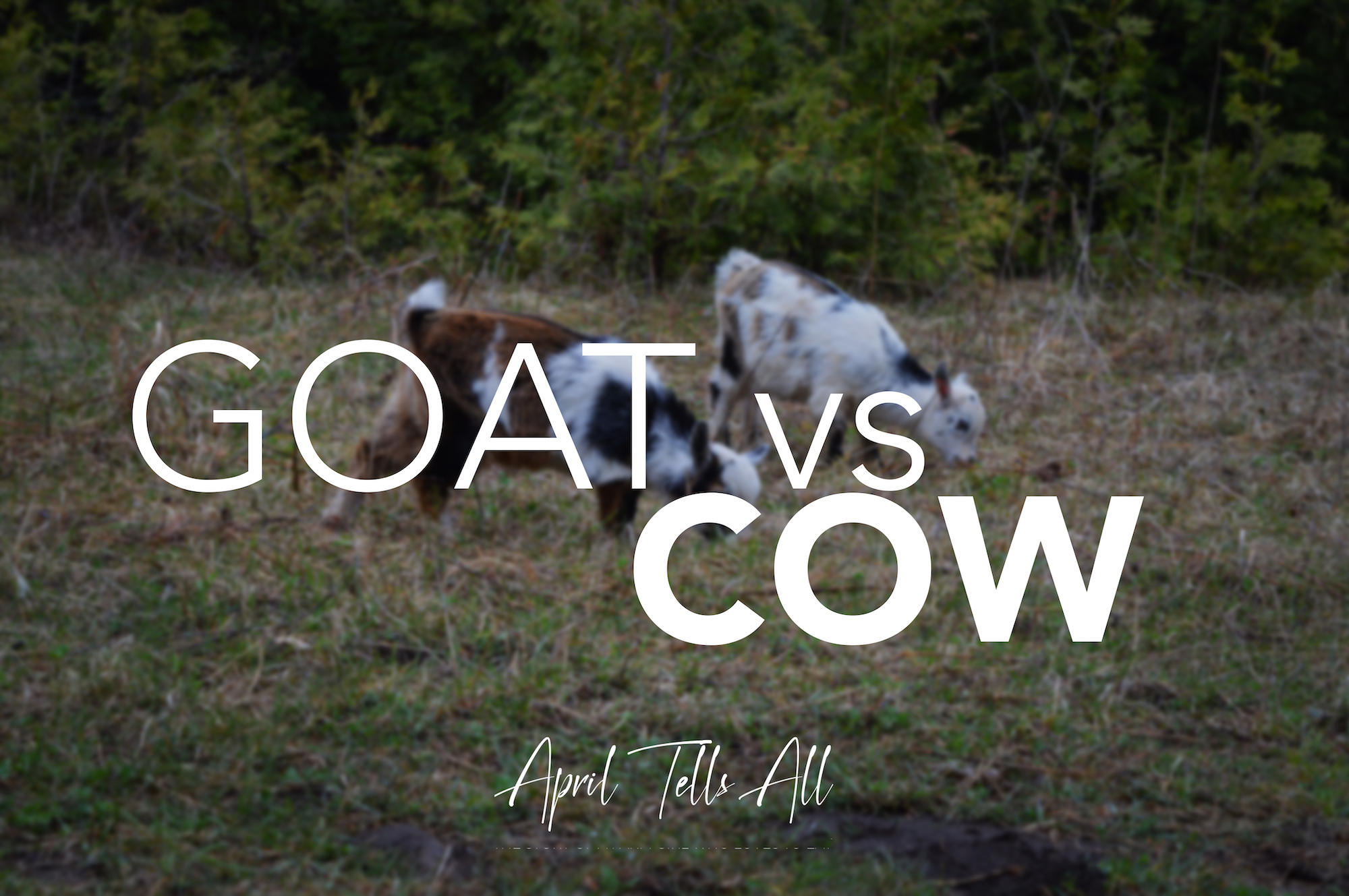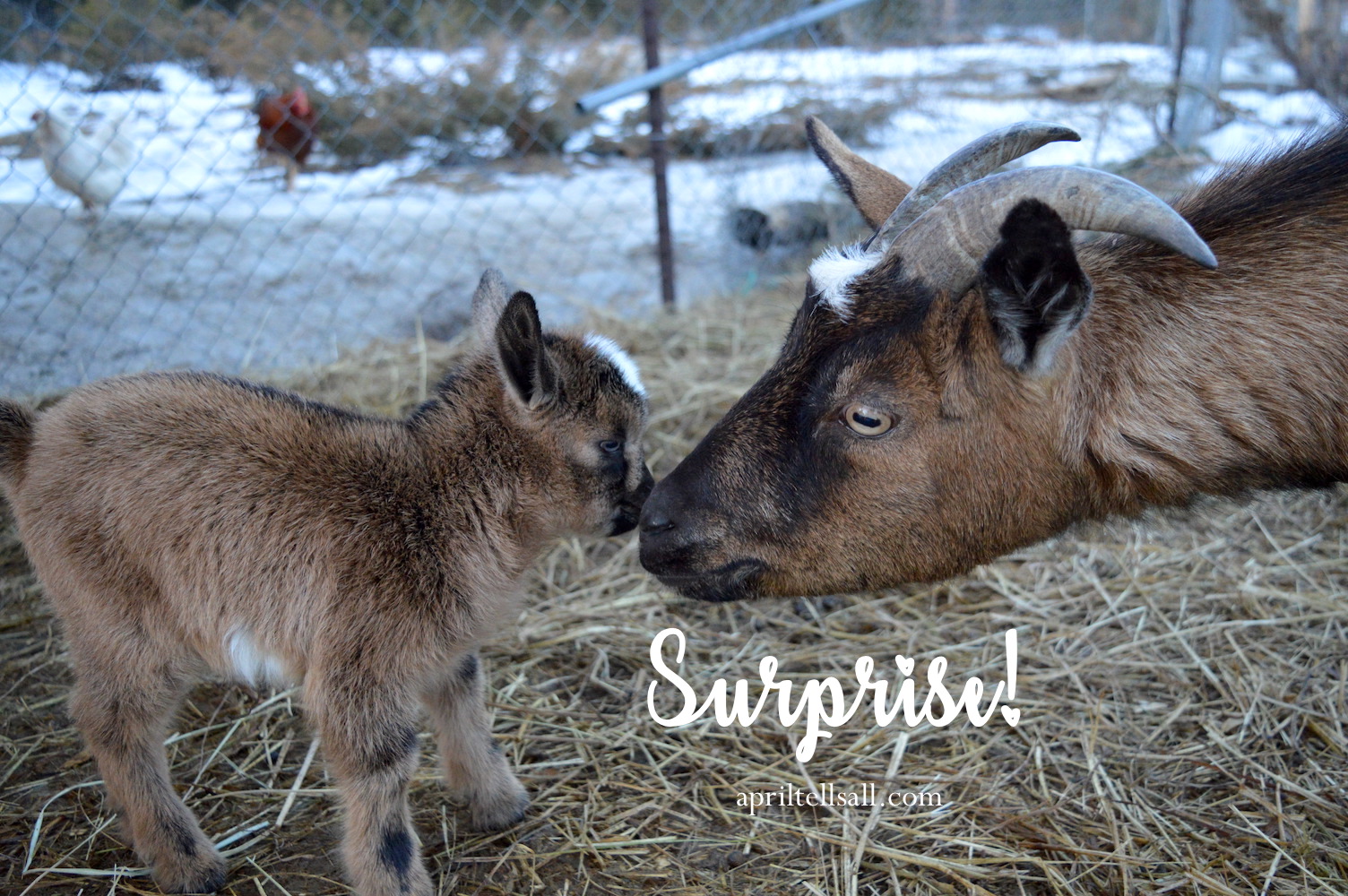Feeding time with our goats was starting to become a frenzy.
They would see me coming with the bucket of grain and wait by the gate to ambush me. It was an all out war as Sophie tried to get out of the pen and Phoebe attacked the bucket of grain.
I would have one leg out trying to keep Sophie in while I tried to squeeze through the tiny opening at the gate (if I opened it all the way and she’d be out), and with the other leg I’d be trying to beat off Phoebe who just goes CRAZY when she knows grain is coming. She jumps all over me and tries to knock the bucket out of my hand with her horns.
Then they would all attack me as I tried to equally split the grain into four portions and put it in their dishes. They’d jump over each other and run into me, try to get their face in the bucket, knock over the bucket, knock me over, and head butt each other.
Finally when I got the grain into the dishes and dove out of the way they would begin this crazy dance of running to each dish and head butting each other out of the way. Jackson wants this one, no actually he wants that one, no actually he wants this one. He would chase every one out (even though the dishes were spread far apart), and eat the majority of the grain while the other three get a bite here and there when he wasn’t looking.
This would prompt Phoebe to cry. Think brat in the candy aisle of the grocery store and you come close to how Phoebe sounds. All out screaming is the only way Phoebe knows how to cry, and it makes me want to cut my ears off. I detest her wail.
And so enough was enough! I could not take this horror show every single night. So this is how we now feed our goats.
First off I don’t like feeding grain to my goats. Forage and good grass hay are all that’s needed to keep a goat in prime condition. Grain can cause weight gain, bloat, and digestive upsets (and also seems to make my goats moody and pushy. They tend to turn into absolute brats when they get grain). However, when more energy is needed, such as when a doe is pregnant or lactating, or kids are growing, or a buck is in rut, grain works as a good and fast energy source. We fed our two does a premixed goat ration for a few months when we brought them home as young kids before switching them over to only getting grass hay, and whatever they could find when out grazing. We just started grain feeding again because the two does are supposed to be pregnant.
How Much We Feed:
We have 2 pregnant does, one growing kid, and one adult wether. (Please note these feeding portions are for Nigerian Dwarf goats, and a Pygmy goat. For a standard size goat you may want to double this.)
For the does we feed: 1 cup of alfalfa pellets, and 1/2 cup of grain (the grain will increase to 1 cup when they are about 100 days into their pregnancy, and when we are milking them).
For the buckling kid we feed: 1/2 cup of grain
For the adult wether we feed: 1/4 cup of grain (technically he doesn’t need grain as this will make him more likely to develop urinary calculi, and put on unnecessary weight. We currently feed him a little grain because he’s in the pen with three other goats who get grain, and I felt bad leaving him out. It is also possible that it will help keep his body heat up with the cold nights we’ve been having.)
*This is per day.
**We are going to keep our young buckling on grain for a bit longer than we kept our does on grain when they were doelings only because of the weather. It gets down to -40C at night and that little guy is going to need something to keep him warm! When spring comes and our buckling and wether are moved to their own pen they will be taken off the grain ration and be given only hay and whatever they can find when out grazing. When Oliver is needed for breeding and goes into rut we will start the grain ration again at about 1/4 – 1/2 cup per day.
Free Choice
- They have free choice hay (mixed hay – mainly timothy with some alfalfa and grass mix) – goats are huge wasters of hay. We try to ration it slightly. As long as there is a little left the next time we go out we know that they’ve had enough. If there is none left we feed slightly more. If there is lots left and thrown all over the ground we feed slightly less. We don’t measure our hay, we just grab a large portion of it for each feeding.
- Baking soda (Sodium bicarbonate)
- Kelp (occasionally)- (Update: I’ve started feeding free choice kelp daily now, and after a few days of them not touching it at all, they eat two big bowls full daily now (between 4 goats). They all have beautiful coats now also. I’m not sure if this is related but I’m planning to continue free choice kelp.)
- Minerals (2:1 calcium to phosphorous is the ratio you want for goats. We use a dairy cow mineral mix. Beware of goat minerals that are labelled for goats and sheep. Goats need copper but copper will kill sheep so that goat and sheep mineral is actually just for sheep. In our area I can’t get a mineral mix for just goats).
I also give our goats raw ACV in their water, or mixed into their grain portion.
How We Feed Our Goats
Each goat has his or her own food dish, and they are each tied to a fence post at feeding time. Each goat goes to the same spot every night. I tie each goat up then bring in their food bowls with their portioned amount of grain. No more feeding frenzy. This also gives me time to clean up the goat stall a bit, fill up the hay feeder, minerals, and water, while they are tied out of the way. Once everyone is finished eating they are released, and the food bowls picked up and brought back inside for the next nights feeding. (*Note: I found this method of feeding to be genius. It keeps everyone calm, I know how much each goat is eating, I know each goat got their proper portion, and if one were to ever need medications or supplements added to their food I would know that only that goat is getting it. But I cannot take credit for this awesome idea. It came from Fias Co Farm. If you ever need to know anything about goats that is the place to go.)
Our Feeding Schedule
8 am – Fill up hay feeder (we have two. One in their stall and one in the yard. We fill both). Fill minerals.
1:30 pm – Fill up hay feeders again.
4 pm – Grain portion. Fill hay feeders. Fill minerals and baking soda.
We check the water throughout the day and fill as needed. Now that it’s winter time and bloody cold outside I boil water for them and take it out about once every hour. Goats dehydrate fast so always make sure they have fresh water. Also I have found that my girls are very picky when it comes to their drinking water. If its got a fleck of dirt in it they won’t drink it. Always make sure your goats are drinking and change the water if they’re not. Keep the drinking pail clean too.
I have found that my goats especially love warm water in the winter time. I boil water and add it into their bucket to thaw out the frozen water that’s sitting in it. This makes it nice and warm (make sure it’s not too hot!), and they usually will drink a lot of it.
What We Feed
 |
| Our own homemade grain ration vs. premixed goat ration from our local feed store (notice how dusty the premixed is) |









Excellent tips here April. We had the same problems with our goats when it came to feeding time and it drove me nuts too. The one goat always chased off the others and I would have to stand guard so the others could it. It was crazy. I will have to put this suggestion to use. Thanks for the post.
Glad you enjoyed it Victoria!
We just got a dwarf Nigerian last night to keep our Saanen company. I was wondering about how much to feed him! He’s already a round little guy! Thanks for the tips!
You’re welcome Amanda! Hope your new guy is settling in nicely to his new home
This is great information! Thank you for sharing.
What is the baking soda for?
Thanks for reading Teresa! The baking soda helps balance the pH in their rumen. Grain is an acidic food and the baking soda will help neutralize that.
Hi April, thanks for the good read. So for us we have 2 doelings and 3 wethers. All born in March 2017. We have them just for pets/enjoyment…..nothing more. They have been weaned from their Mom’s milk and eating hay with no issues. I want to make sure that I am feeding them OK and that they are getting what they need. I was told that since they are little still I need to feed them grain until they get a little older. I have been doing Noble feed with a little bit of BOSS mixed in. They have free range hay, loose minerals and water at all times. I would like to feed them all the same to make it easier on us and for the fact we are not breeding/milking our Does. I know that male goats can get urinary Calculi, so I understand I have to be careful what I feed them. Do you feel like I’m doing this correct? Or do I need to change things up a bit? Any info would be helpful. We are first time goat owners. Thanks!!
Hi Tara, first off congratulations on your new goats! It sounds like you are on the right track for their feeding. I would keep feeding them as you are. When they get to be around a year you can wean them off the grain or just reduce their amount. My wethers get about a 1/4 cup of grain in the morning because my does get grain. I agree, it is way easier to feed them the same.
Hi April!
Thank you so much for this informative article! I was curious where you buy your barley and oats? Does it matter if the barley is “pearled“ or “hulled”
Thanks!
Amy